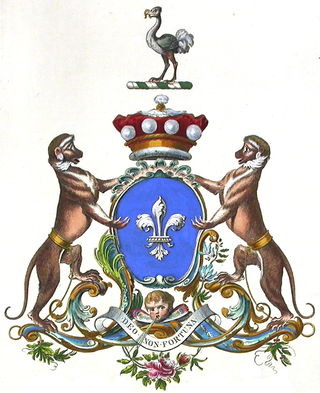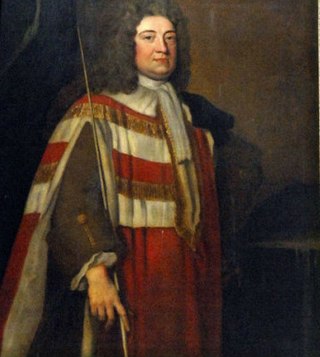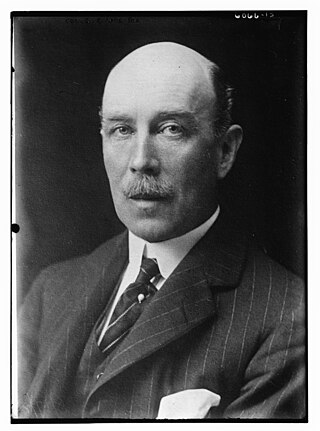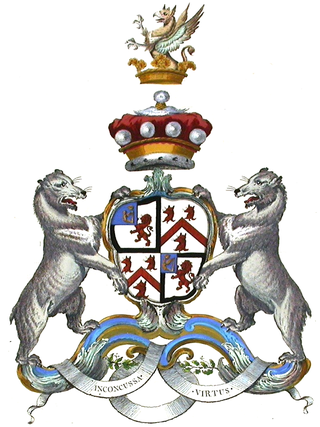
Earl of Cork is a title in the Peerage of Ireland, held in conjunction with the Earldom of Orrery since 1753. It was created in 1620 for Richard Boyle, 1st Baron Boyle. He had already been created Lord Boyle, Baron of Youghal, in the County of Cork, in 1616, and was made Viscount of Dungarvan, in the County of Waterford, at the same time he was given the earldom. These titles are also in the Peerage of Ireland.

Baron Lyttelton is a title that has been created once in Peerage of England and twice in Peerage of Great Britain, both times for members of the Lyttelton family. Since 1889 the title has been a subsidiary title of the viscountcy of Cobham.

Earl of Carlisle is a title that has been created three times in the Peerage of England.

Marquess Townshend is a title in the Peerage of Great Britain held by the Townshend family of Raynham Hall in Norfolk. The title was created in 1787 for George Townshend, 4th Viscount Townshend.

Earl Erne, of Crom Castle in the County of Fermanagh, is a title in the Peerage of Ireland. It was created in 1789 for John Creighton, 2nd Baron Erne, who had earlier represented Lifford in the Irish House of Commons. He had already been made Viscount Erne, of Crom Castle in the County of Fermanagh, in 1781, also in the Peerage of Ireland, and sat from 1800 to 1828 as an Irish representative peer in the British House of Lords. The title of Baron Erne, of Crom Castle in the County of Fermanagh, was created in the Peerage of Ireland in 1768 for his father Abraham Creighton. The Earl was succeeded by his eldest son, the second Earl. On his death the titles passed to his nephew, the third Earl. He was an Irish Representative Peer from 1845 to 1885 and also served as Lord Lieutenant of County Fermanagh during the same period. In 1876 he was created Baron Fermanagh, of Lisnaskea in the County of Fermanagh, in the Peerage of the United Kingdom. This was to allow the Earls to sit in the House of Lords by right, rather than having to stand for election as Representative Peers. An earlier title of Baroness Fermanagh in the Peerage of Ireland was created for Mary Verney on 13 June 1792, but became extinct on her death on 15 November 1810.

Earl Granville is a title that has been created twice, once in the Peerage of Great Britain and once in the Peerage of the United Kingdom. It is now held by members of the Leveson-Gower family.

Earl of Plymouth is a title that has been created three times: twice in the Peerage of England and once in the Peerage of the United Kingdom.

Viscount Galway is a title that has been created four times in the Peerage of Ireland. The first creation came in 1628 in favour of Richard Burke, 4th Earl of Clanricarde. He was made Earl of St Albans in the Peerage of England at the same time.

Baron Digby is a title that has been created twice, once in the Peerage of Ireland and once in the Peerage of Great Britain, for members of the same family.

Duke of Kingston-upon-Hull was a title in the Peerage of Great Britain, with the title Earl of Kingston-upon-Hull being a title in the Peerage of England. The earldom was created on 25 July 1628 for Robert Pierrepont, 1st Viscount Newark. The dukedom was created on 10 August 1715 for his great-grandson, Evelyn Pierrepont, 1st Marquess of Dorchester, who had succeeded as the fifth Earl of Kingston-upon-Hull in 1690. The dukedom became extinct on the death of the second Duke in 1773. Unlike the city to which they refer, Kingston upon Hull, which is usually shortened to Hull, these titles are usually shortened to Duke of Kingston.. They should not be confused with the separate Irish Earldom of Kingston.

Robert Benson, 1st Baron Bingley, was an English Tory politician who sat in the English and British House of Commons from 1702 until 1713 when he was raised to the peerage as Baron Bingley and sat in the House of Lords. He served as Chancellor of the Exchequer from 1711 to 1713.
Earl of Lanesborough was a title in the Peerage of Ireland. It was created in 1756 for Humphrey Butler, 2nd Viscount Lanesborough. The Butler family descended from Theophilus Butler, who represented County Cavan and Belturbet in the Irish House of Commons. In 1715 he was raised to the Peerage of Ireland as Baron Newtown-Butler, of the County of Fermanagh, with remainder to the heirs male of his father. He was succeeded according to the special remainder by his brother, Brinsley, the second Baron. He had previously represented Kells and Belturbet in the Irish Parliament. In 1728 he was created Viscount Lanesborough in the Peerage of Ireland. He was succeeded by his son, Humphrey, the aforementioned second Viscount, who was elevated to an earldom in 1756. The first Earl was succeeded by his son, Brinsley, the second Earl. He represented County Cavan in the Irish House of Commons. His grandson, the fifth Earl, sat in the British House of Lords as an Irish representative peer from 1849 to 1866. The latter was succeeded by his nephew, the sixth Earl. He served as Lord-Lieutenant of Cavan from 1876 to 1900 and was an Irish Representative Peer from 1870 to 1905. He was succeeded by his son, the seventh Earl. He was an Irish Representative Peer from 1913 to 1929. On his death the titles passed to his younger brother, the eighth Earl. The titles became extinct on the death of the latter's eldest son, the ninth Earl, in December 1998.
Viscount Lanesborough is a title that has been created twice in the Peerage of Ireland. The first creation came on 31 July 1676 in favour Sir George Lane, 2nd Baronet. The titles became extinct upon the death of his son, the second Viscount, on 2 August 1724. The Lane Baronetcy, of Tulske in the County of Roscommon, had been created in the Baronetage of Ireland on 9 February 1661 for Richard Lane. The second creation came on 12 August 1728 in favour of Brinsley Butler, 2nd Baron Newtown-Butler. His son Humphrey was created Earl of Lanesborough in 1756. See the latter title for more information on this creation.

George Richard Lane Fox, 1st Baron Bingley, PC was a British Conservative politician. He served as Secretary for Mines between 1922 and 1924, and again between 1924 and 1928.
There have been three baronetcies created for members of the Gore family, all in the Baronetage of Ireland. All three titles are extant. The family also holds two earldoms and a barony.

Bramham Park is a Grade I listed 18th-century country house in Bramham, between Leeds and Wetherby, in West Yorkshire, England.

George Fox-Lane, 1st Baron Bingley was a British peer and Tory politician.
George Lane, 1st Viscount Lanesborough was an Irish politician.
George Lane-Fox, of Bramham Park, Yorkshire, was a British landowner and Tory politician.
Ulick Burke, 1st Viscount Galway was an Irish army officer slain at the Battle of Aughrim while fighting for the Jacobites during the Williamite War in Ireland.













